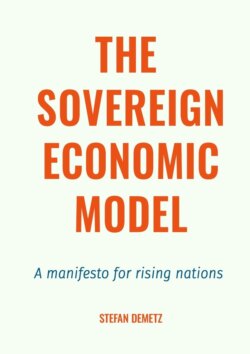Читать книгу The Sovereign Economic Model. A manifesto for rising nations - Stefan Demetz - Страница 5
The sovereign economic model
Problems and Solutions for Liberal Economics
ОглавлениеLimitations, vices, and excesses are hallmarks of the current liberal capitalism; it has hit a brick wall. It is afflicted by huge excesses like boom-bust cycles, bubbles, extreme financialization, and enormous debt but offers limited or no improvement for most people. Most times, it even worsens wealth distribution, purchasing power, and employment and demands higher taxes. The Sovereign Economic Model looks at alternative ways to do business, to structure a country’s economy to improve the lives of its people, and to remove the undesirable traits of capitalism. It is not intended to apply communist or socialist economic theories, but proposes a new mindset to improve current economic models so that they more closely align with the common good. Currently capitalism has the following generic disadvantages (free market failures), but they are evolved and exasperated to the limit:
• Inequality
• Financial instability/economic cycle
• Monopolies and cartels
• Environmental costs and externalities
• Greed
• Materialism
• Over-financialization
• Undemocratic practices
• Inefficient allocation of resources
• Misalignment with the «common good»
If the current system is not reined in, long-term problems will render the situation worse and cause a collapse of the financial and economic systems. Change is complex and is resisted by those who thrive on and profit from the status quo. Both China and Russia consider profiteering and excessive profits absolutely negative for the economy. They are forcing companies to diversify in economic sectors that need capital or to transfer profits into investment funds to put to good use for economic development.
One example of a problem caused by profiteering is that speculation leads to overexposure in some fields. When one economic sector becomes the rage, all investments rush into that field to reap as much profit as possible. This creates bubbles, and assets become overvalued. Over-allocation of resources in fields like real estate raises the cost of living to unbearable levels for many people.
An example of how China has prioritized the common good over profits relates to the country’s redirection of social development. China experienced an explosion of edu-tech and private tuition for kids. This allowed prosperous citizens to buy extra tuition for their children to better compete with other students in education. The differences in student achievement levels created inequalities in society and a great deal of unease in academia. China blocked these businesses, canceled their business licenses, and made the sector nonprofit by default.
Another problem is that unhealthy, addictive habits can lead to social-economic inefficiency. To mitigate this problem, China also recently introduced a one-hour limit on gaming for children. Its goal is to lessen children’s overexposure to an unhealthy addiction to online video games and screens to avoid social problems.
In inefficient industries, companies take the path of least resistance and lowest cost rather than using the latest technologies or production methods, so in time they become outdated and lose out to competitors. That was the case for German carmakers. They did not progress the automotive sector into new technologies, so competitors overtook them and conquered the market. Russia, in its various state investment programs, is strict on this issue and requires efficient production methods using the latest technologies. One example in Russia is fishing quotas, which depend on fishing vessels with high functionality and efficiency levels. Many fishing companies had to order completely new vessels to receive sufficient quotas.
Yet another issue in capitalism is inefficient capital allocation for investments. As the capitalist model has evolved with its limitations, moments of wrong and inefficient allocation of resources persist. A case in point is when a company produces extremely large profits but does not invest in R&D for new products, increased production, or higher quality. Instead, it reinvests them to make even higher profits and returns for shareholders. Boeing provides an example of preferring share buybacks to product innovation. Without R&D, its new 737 MAX suffered two crashes and production had to stop to fix the issues and redo its aviation certifications. The perception and reputation hits were huge, and sales of all Boeing airplanes are lagging.
Also, on the consumer side, the common good and the free market do not align. Thus, the government must intervene. Usually there are laws and regulating interventions to minimize the most common issues, like these:
• Price fixing
• Minimum wage
• Pollution control
• Protection of financial systems
• Workers’ rights
• Competition and antitrust laws
• Consumer rights (privacy laws)
• Restriction of products (tobacco, alcohol, junk food) for health reasons
• Restriction of services leading to dependency or addiction (gaming, gambling)
China is currently at the forefront of economic optimization and is severely curtailing and restricting unproductive and inefficient allocation of investments that have negative consequences for its economic and social well-being. While in the short-term there might be losses in GDP, the long-term benefit will be a healthier economy as investments are forced into more productive business activities. I hope that most countries follow China’s lead in this endeavor.
